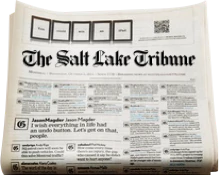This is an archived article that was published on sltrib.com in 2006, and information in the article may be outdated. It is provided only for personal research purposes and may not be reprinted.
PAROWAN - Aunt Pliny has returned to Parowan.
To celebrate its pioneer heritage, about 500 residents of the first settlement in southern Utah gathered Saturday in Heritage Park for the dedication of a bronze statue of Paulina Phelps Lyman, who between her arrival in the town in 1858 and death 54 years later, helped deliver more than 1,000 babies.
"For decades she was the only medical help in Parowan," said Elaine Paulson, who participated in the ceremony that included pulling handcarts to Parowan from Paragonah 10 miles to the north. The reenactment was to honor Utah pioneers who pulled the carts containing their possessions to Utah between 1856 and 1860.
Lyman is still known here as Aunt Pliny.
She was sent to Parowan by Brigham Young. Many here are descendants of those delivered by Lyman.
"The children used to believe that Aunt Pliny brought the babies to their house in her black, doctor's bag," said Paulson.
The bag is part of the statue created by Parowan artist Stanley Johnson.
He fashioned Lyman in her traditional long dress, shawl, hair in a tight bun and brooch clasping her dress closed at the throat.
Johnson said he made her likeness from photographs and that it was a miracle he finished the creation because of a recent bout of carpal-tunnel syndrome.
"I gave her motion so it looks like she is walking," said Johnson.
The statue, placed on a sandstone boulder pedestal, joins one of early settler Parley Pratt in the tidy little park of the town that was incorporated in 1851.
The $30,000 statue was commissioned by the town's Heritage Committee.
Paulson said Lyman was a plural wife of Church of Jesus Christ of Latter-day Saints apostle Amasa Lyman and had several children of her own.
Born in Macedonia, Ill. in 1827, Lyman later lived in Nauvoo, Ill., and fled that community with the Mormon exodus for Iowa. She was also part of the initial migration to the Salt Lake Valley in 1847, driving a wagon drawn by four horses.
According to biographer Nevada Driggs, Lyman never had a formal education, but made a point to read an hour a day, something she did all her life.
Ronald T. Halverson, a member of the LDS Church's Second Quorum of Seventy, dedicated the statue, saying Lyman represented all pioneer women who sacrificed and served the church.
Norine Johnson, a descendant of the original settlers of Parowan who now lives in Salt Lake City, took part in the reenactment of the handcart migration and said it gave her new respect for her forebears.
"At 79, you don't want to walk in the sun too long." she said.

